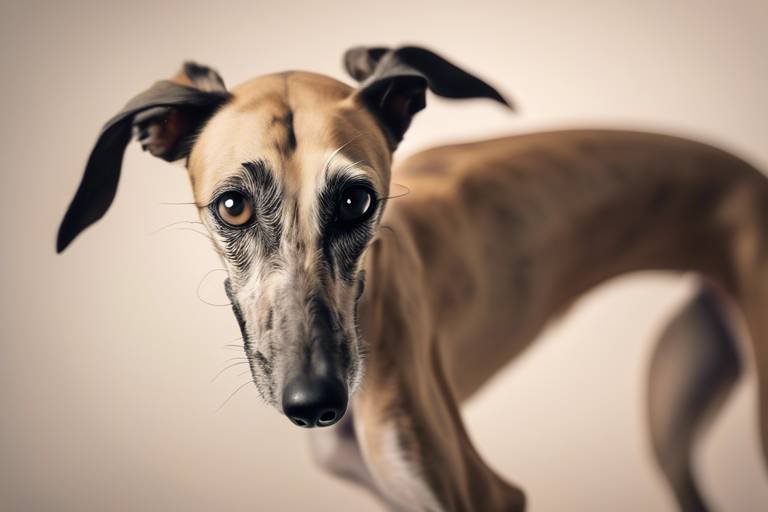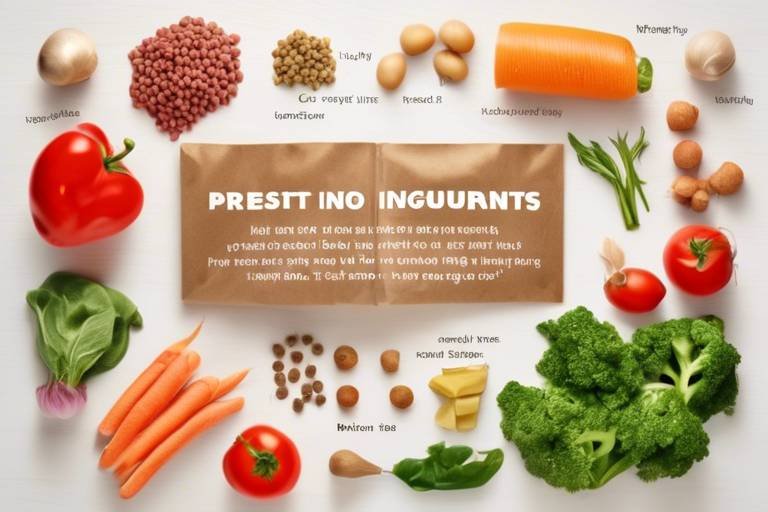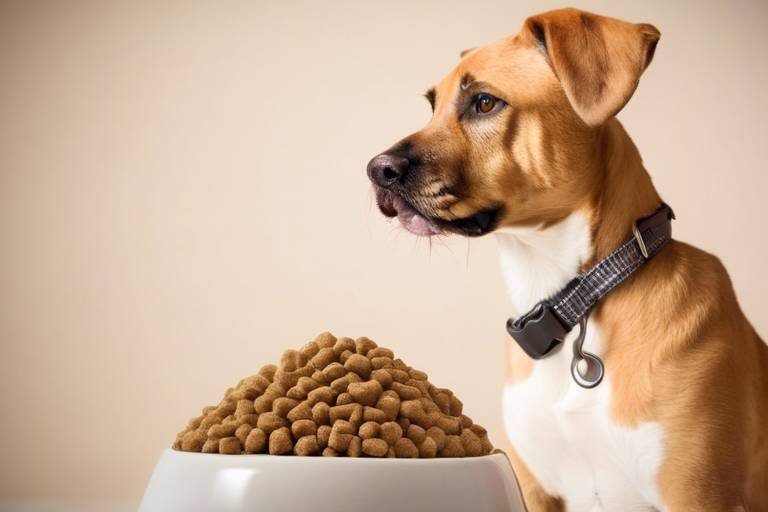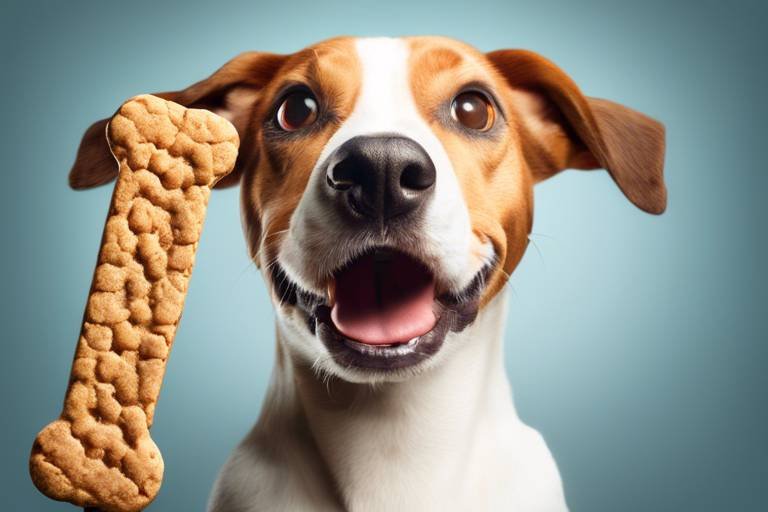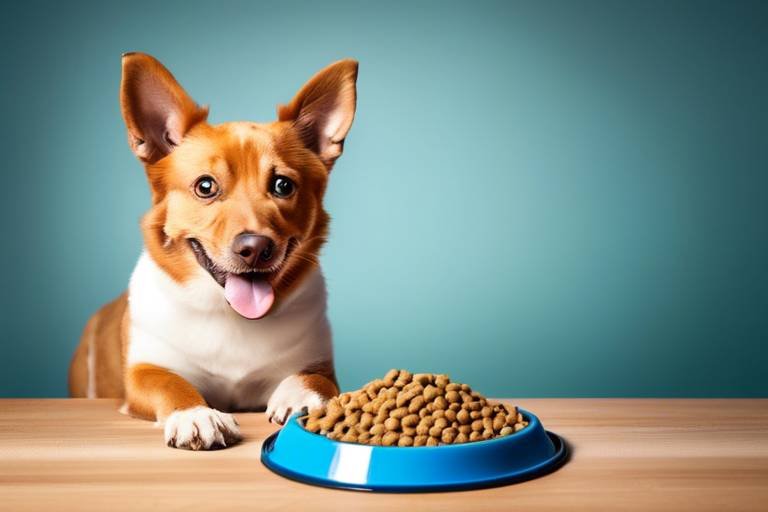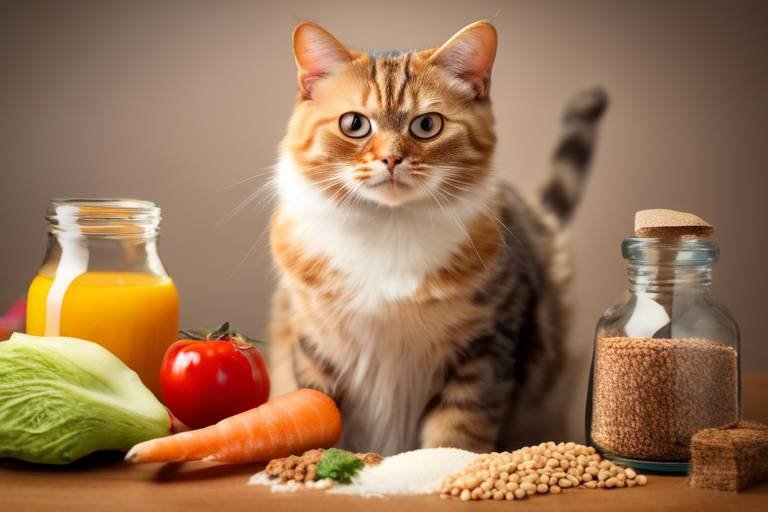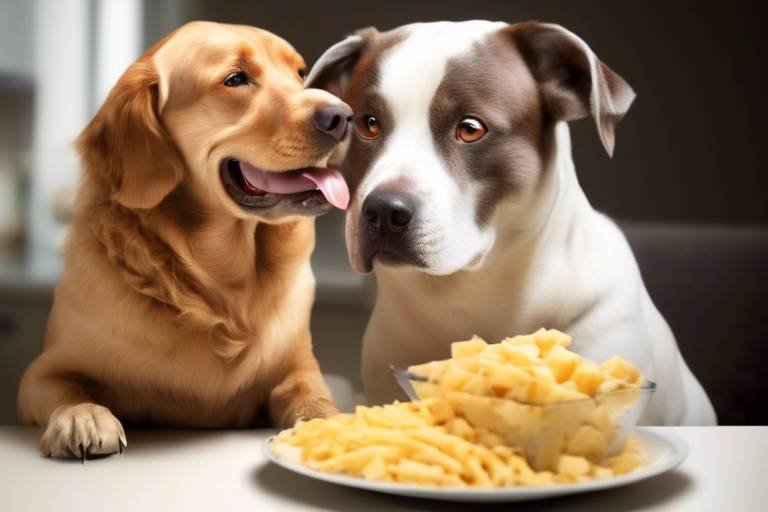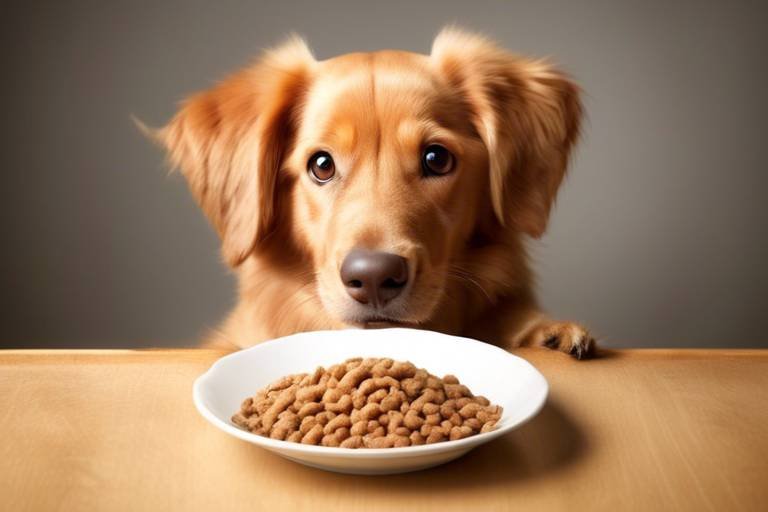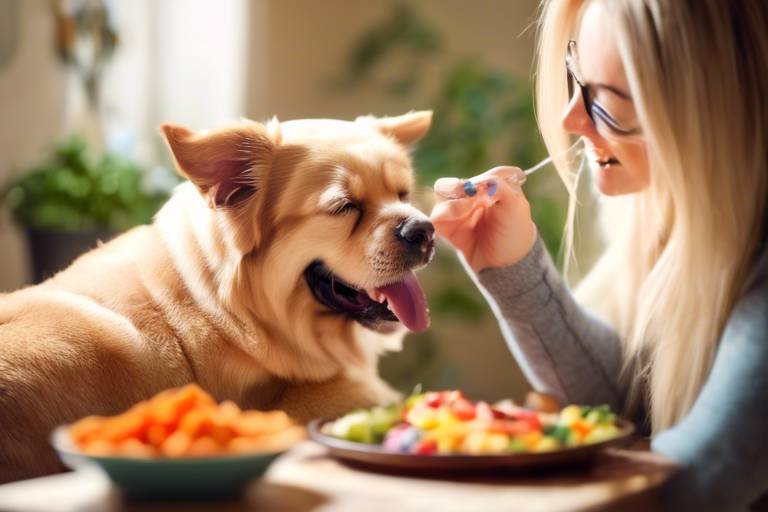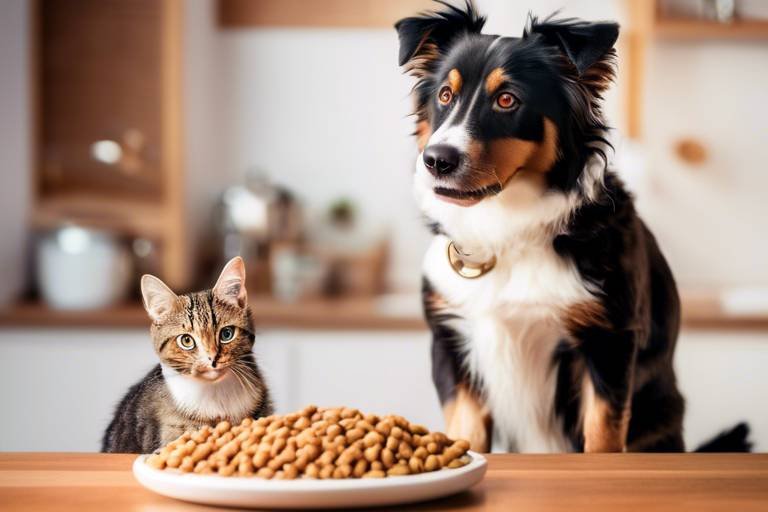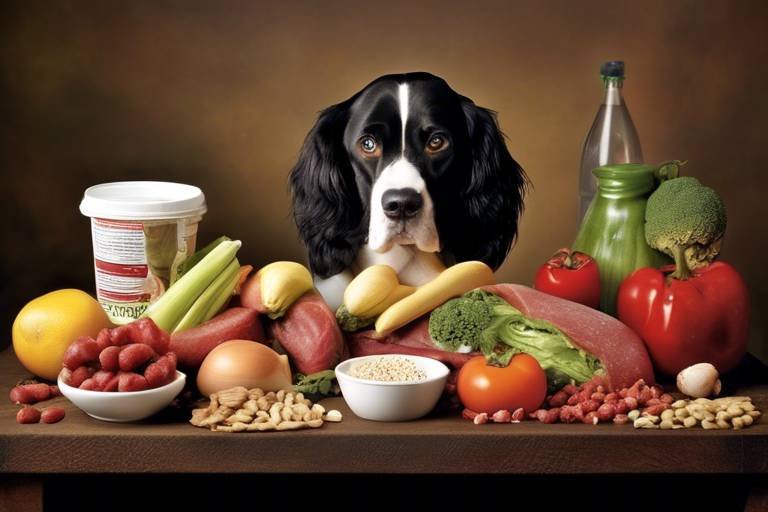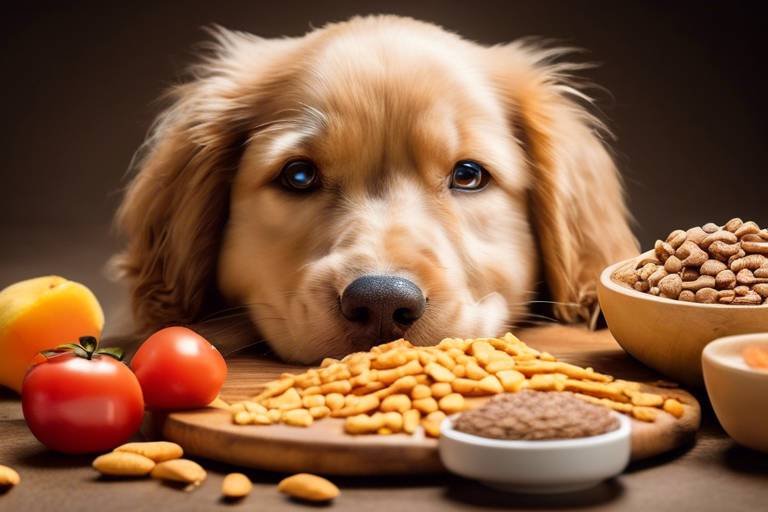Understanding the Nutritional Needs of Sighthounds
When it comes to our furry companions, understanding their unique nutritional needs is crucial, especially for sighthounds. These elegant dogs, known for their speed and grace, possess a metabolic profile that sets them apart from other breeds. Their bodies are designed for sprinting, which means they require a specific balance of nutrients to support their high-energy lifestyle. Just like a finely tuned sports car needs premium fuel, sighthounds thrive on a diet tailored to their unique physiology.
So, what makes sighthounds different in terms of nutrition? For starters, their metabolism is incredibly efficient, allowing them to convert food into energy rapidly. This means that they burn through calories much quicker than many other breeds, which can lead to weight loss if their dietary needs aren't met. Owners must pay close attention to how much and what type of food they are providing to ensure that these dogs maintain their ideal body condition. Think of it like a balancing act; too much or too little can tip the scales in the wrong direction.
Moreover, sighthounds are known for their lean bodies and low body fat percentage. This unique physique means that they require a diet rich in high-quality proteins and healthy fats to support their muscle mass and energy levels. Unlike some breeds that can thrive on a more carbohydrate-heavy diet, sighthounds benefit from a higher protein intake to fuel their athleticism. It's essential to consider not just the quantity of food but also the quality of ingredients used in their meals.
Another aspect to consider is their feeding schedule. Sighthounds can be prone to certain digestive issues, so feeding them smaller, more frequent meals can be beneficial. This approach helps maintain stable energy levels throughout the day and reduces the risk of gastrointestinal problems. Imagine trying to run a marathon on a full stomach; it just doesn't work! By spacing out their meals, we can help our sighthounds feel their best and perform at their peak.
In summary, understanding the nutritional needs of sighthounds is not just about filling their bowls with food. It involves a thoughtful approach to their diet, considering their unique metabolism, body composition, and feeding habits. By providing a balanced diet rich in proteins and healthy fats, along with a proper feeding schedule, we can ensure that these remarkable dogs thrive in both health and performance.
- What type of protein is best for sighthounds? Sighthounds benefit from high-quality animal proteins such as chicken, beef, and fish. Plant-based proteins can also be included but should not be the primary source.
- How often should I feed my sighthound? It's generally recommended to feed sighthounds two to three smaller meals a day to prevent digestive issues.
- Can sighthounds have grains in their diet? While some sighthounds can tolerate grains, it's best to focus on a diet that prioritizes proteins and healthy fats. Always consult your veterinarian for personalized advice.
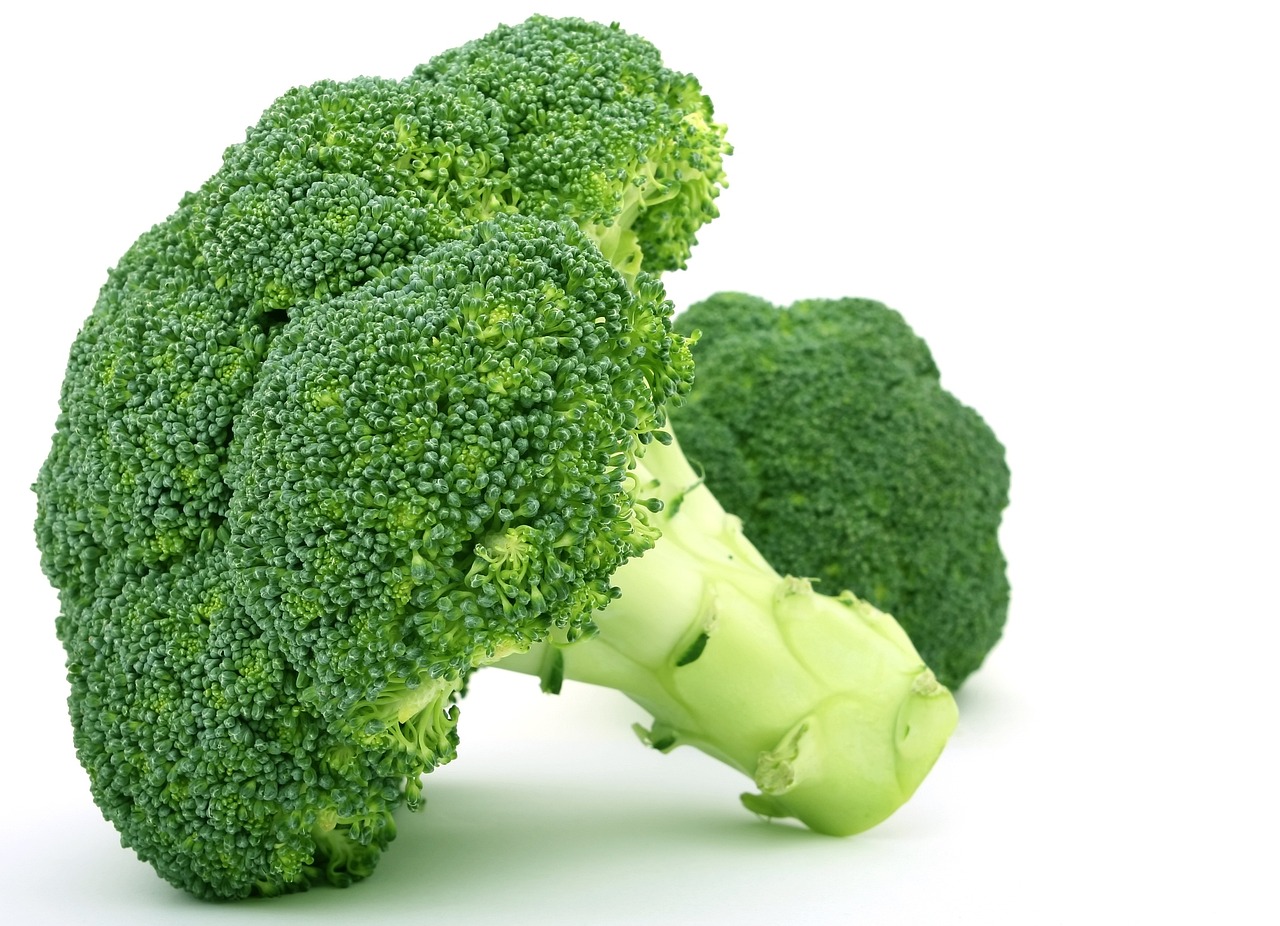
The Unique Metabolism of Sighthounds
Sighthounds, known for their incredible speed and agility, have a unique metabolic profile that sets them apart from other dog breeds. This distinct metabolism is largely influenced by their evolutionary background as hunters, which has shaped their energy requirements and dietary needs. Understanding these differences is essential for any owner who wants to keep their sighthound healthy and thriving.
One of the most notable aspects of a sighthound's metabolism is their efficient energy utilization. Unlike many other breeds that may rely on a more balanced mix of fats and carbohydrates, sighthounds are built for short bursts of intense activity, effectively using fats as their primary energy source. This means that their diet should be rich in high-quality fats, which not only provide energy but also support overall health. Furthermore, sighthounds tend to have a higher basal metabolic rate, which means they burn calories faster than many other breeds. This can lead to a greater need for food, especially for those that are active or working dogs.
Additionally, sighthounds have a lean body structure, which means they have less muscle mass compared to other breeds. This can affect their nutritional needs, particularly in terms of protein intake. A sighthound's body is designed for speed rather than endurance, and this specialized physiology requires a diet that caters to their specific needs. For instance, the protein requirements for sighthounds are often higher than average, which is crucial for maintaining their muscle health and supporting their energetic lifestyle.
Moreover, the digestive system of sighthounds is quite different. They have a shorter gastrointestinal tract, which means food passes through their system more quickly. This characteristic can lead to challenges in digesting certain types of food, particularly those high in fiber or fillers. As a result, it’s important for owners to choose diets that are easily digestible and rich in quality ingredients. A diet that includes high-quality proteins and healthy fats can help mitigate any digestive issues and ensure that these dogs receive the nutrients they need.
In conclusion, understanding the unique metabolism of sighthounds is key to providing them with the right nutrition. By focusing on high-quality proteins and fats, and being mindful of their digestive needs, owners can help their sighthounds maintain optimal health and performance. It’s not just about feeding them; it’s about feeding them right!

When it comes to the nutritional needs of sighthounds, it's essential to recognize that these magnificent dogs are not just your average canines. Their unique physiology demands a diet that is both rich and balanced, tailored specifically to support their high energy levels and lean body structure. The key nutritional components that should be emphasized in a sighthound's diet include proteins, fats, carbohydrates, vitamins, and minerals. Each of these elements plays a pivotal role in ensuring that your sighthound remains not only healthy but also active and vibrant.
First and foremost, proteins serve as the building blocks of your sighthound's body. They are crucial for muscle development, repair, and overall growth. Sighthounds, being athletic and agile, thrive on a diet that offers a higher protein percentage compared to other breeds. Ideally, their diet should consist of around 30% to 40% protein, which can be sourced from high-quality meats such as chicken, beef, lamb, or fish. It’s important to note that not all protein sources are created equal; the quality and digestibility of the protein should be prioritized to ensure your dog can utilize it effectively.
Next up are fats, which provide a concentrated source of energy for sighthounds. These dogs have a high metabolism, and fats are essential for maintaining their energy levels, especially during activities such as running and playing. Healthy fats, such as omega-3 and omega-6 fatty acids, support skin health and coat quality, making them vital for sighthounds. When selecting a dog food, look for options that include fish oil or flaxseed oil, which are excellent sources of these essential fatty acids. Generally, a fat content of around 15% to 20% is ideal for sighthounds.
While proteins and fats are critical, we must not overlook carbohydrates. These macronutrients serve as a quick energy source, helping to fuel your sighthound during their adventures. However, it’s essential to choose the right types of carbohydrates. Complex carbohydrates, such as sweet potatoes and brown rice, are preferable as they provide a steady release of energy without causing spikes in blood sugar. You might consider including a small percentage of carbohydrates, around 20% to 30%, in their diet to ensure they have the energy they need without overloading on sugars.
Vitamins and minerals are also vital components of a sighthound's diet. They support a range of bodily functions, from immune system health to bone strength. A balanced diet should include a variety of fruits and vegetables to provide these essential nutrients. Foods like carrots, blueberries, and spinach are not only safe for dogs but also packed with vitamins that can enhance their overall well-being.
To summarize, here’s a quick overview of the key nutritional components for sighthounds:
| Nutritional Component | Recommended Percentage | Sources |
|---|---|---|
| Protein | 30% - 40% | Chicken, Beef, Fish |
| Fats | 15% - 20% | Fish Oil, Flaxseed Oil |
| Carbohydrates | 20% - 30% | Sweet Potatoes, Brown Rice |
| Vitamins & Minerals | As needed | Fruits & Vegetables |
By understanding and implementing these nutritional components, you can ensure that your sighthound enjoys a balanced diet that meets their unique needs. Remember, a well-fed sighthound is not only healthier but also happier, ready to chase after their next adventure with vigor!
- What is the best protein source for sighthounds? High-quality meats such as chicken, beef, and fish are ideal.
- How often should I feed my sighthound? It's generally recommended to feed them twice a day, but consult your vet for personalized advice.
- Are there any foods I should avoid? Yes, avoid foods that are toxic to dogs, such as chocolate, grapes, and onions.
When it comes to the dietary needs of sighthounds, one of the most crucial elements is protein. These elegant canines have a unique physiology that demands a higher protein intake compared to many other breeds. Why is that, you may ask? Well, sighthounds are built for speed and agility, and their lean muscle structure requires a consistent supply of quality protein to maintain their energy levels and overall health. Think of protein as the fuel that keeps their engines running smoothly.
Protein plays a vital role in various bodily functions, including muscle repair, immune function, and hormone production. For sighthounds, who often engage in high-intensity activities, adequate protein is essential for recovery after exercise. A diet that is rich in protein helps to prevent muscle wastage, ensuring that these dogs remain in peak physical condition. So, how much protein do they actually need? Generally, sighthounds should consume a diet that contains at least 30% protein, with some active individuals requiring even more.
When selecting protein sources for your sighthound, it's essential to consider both the quality and the digestibility of the protein. Animal-based proteins, such as chicken, beef, lamb, and fish, are typically more digestible and provide a complete amino acid profile that is crucial for your dog's health. In contrast, plant-based proteins, while beneficial, may not offer the same level of completeness. However, they can still be included in moderation to provide variety in your dog's diet. Here’s a quick overview of some excellent protein sources:
| Protein Source | Benefits |
|---|---|
| Chicken | Lean, easily digestible, and rich in essential amino acids. |
| Beef | High in iron and zinc, supports muscle development. |
| Lamb | Good for dogs with food sensitivities, rich in omega-3 fatty acids. |
| Fish | High in omega-3 fatty acids, beneficial for skin and coat health. |
In some cases, you might find that your sighthound requires additional protein supplementation, especially if they are highly active or recovering from an injury. Protein supplements can come in various forms, such as powders or treats, and can be a convenient way to boost your dog's protein intake. However, it’s essential to consult with your veterinarian before introducing any supplements to ensure they are appropriate for your dog's specific needs.
In summary, focusing on high-quality protein sources and ensuring adequate protein intake is vital for the health and performance of your sighthound. Remember, a well-nourished sighthound is a happy and energetic sighthound!
- How much protein should my sighthound eat daily? Generally, sighthounds should consume a diet containing at least 30% protein, but this can vary based on their activity level and age.
- Can I use plant-based proteins for my sighthound? Yes, but they should not be the primary source of protein. Animal-based proteins are more complete and digestible.
- What are the signs of protein deficiency in dogs? Signs may include lethargy, poor coat condition, and muscle wasting. If you notice these signs, consult your veterinarian.
When it comes to feeding your sighthound, choosing the right protein sources is crucial for their health and vitality. These elegant dogs, known for their speed and agility, require a diet rich in high-quality protein to support their unique metabolic needs. But what exactly are the best protein sources for these remarkable animals? Let's dive into the options!
First off, animal-based proteins should be the cornerstone of a sighthound's diet. These proteins are not only highly digestible but also provide essential amino acids that are vital for muscle maintenance and overall health. Common animal protein sources include:
- Chicken: A lean meat that is easy to digest and packed with protein.
- Beef: Rich in iron and other nutrients, beef is a great option for sighthounds needing more energy.
- Fish: Salmon and other oily fish provide omega-3 fatty acids, which are excellent for skin and coat health.
- Lamb: Often recommended for dogs with food sensitivities, lamb is another excellent protein source.
In addition to these traditional sources, there are also some less common proteins that can be beneficial. For example, rabbit and venison are lean meats that can be great alternatives, especially for dogs that might have allergies or sensitivities to more common proteins. Moreover, eggs are a fantastic protein source that is often overlooked. They are not only rich in protein but also contain valuable nutrients that can contribute to a sighthound's overall well-being.
While animal proteins should dominate, it's worth noting that some plant-based proteins can also be included in moderation. Ingredients like quinoa and peas can provide additional protein and fiber, supporting digestive health. However, it's essential to ensure that the majority of your sighthound's protein comes from animal sources to meet their unique dietary requirements.
When selecting protein sources, always opt for high-quality options. Look for products that list real meat as the first ingredient and avoid those with fillers or by-products. This ensures that your sighthound is getting the best nutrition possible to fuel their active lifestyle.
In summary, the right protein sources play a pivotal role in maintaining the health and performance of sighthounds. By focusing on high-quality animal proteins and incorporating some plant-based options, you can create a balanced diet that supports their unique needs.
When it comes to meeting the protein needs of sighthounds, sometimes their regular diet just doesn't cut it. This is where protein supplements come into play. These supplements can be a game-changer for sighthound owners looking to boost their dog's protein intake effectively. But when should you consider adding protein supplements to your sighthound's diet? Well, if your furry friend is particularly active, recovering from an injury, or simply not gaining the muscle mass you’d expect, it might be time to look into supplements.
It's essential to recognize that not all protein supplements are created equal. Some are derived from animal sources, while others come from plants. For sighthounds, who thrive on high-quality proteins, choosing the right type is crucial. Animal-based proteins, such as chicken, beef, or fish meal, generally offer higher biological value, meaning they provide more essential amino acids that dogs need. On the other hand, plant-based proteins, like pea protein or hemp protein, can also be beneficial but should be used in conjunction with animal proteins to ensure a complete amino acid profile.
Incorporating protein supplements into your sighthound's diet can be as simple as mixing a scoop into their regular food. However, it’s important to follow the recommended guidelines provided by the manufacturer. Over-supplementation can lead to health issues, so moderation is key. Always consult with your veterinarian before introducing any new supplements to ensure they align with your dog’s specific health needs and dietary requirements.
To give you a clearer picture, here’s a quick comparison of some popular protein supplements that may be suitable for sighthounds:
| Protein Source | Benefits | Considerations |
|---|---|---|
| Whey Protein | High biological value, supports muscle recovery | May cause digestive issues in some dogs |
| Egg Protein | Rich in essential amino acids, easily digestible | Allergic reactions possible |
| Fish Protein | Omega-3 fatty acids for skin and coat health | Potential for heavy metal contamination |
| Pea Protein | Good for dogs with allergies to animal proteins | Lower biological value compared to animal proteins |
In summary, protein supplements can be a valuable addition to a sighthound's diet, but they should be chosen and used wisely. Always prioritize high-quality sources and consult with a veterinarian to tailor the supplementation to your dog's unique needs. Just like us, our furry companions thrive on the right balance of nutrients, and ensuring they get enough protein is a big part of that puzzle.
1. Can I give my sighthound protein supplements daily?
Yes, but it’s important to follow the recommended dosage and consult your veterinarian to avoid over-supplementation.
2. What are the signs my sighthound needs more protein?
Signs may include low energy levels, difficulty maintaining muscle mass, or a dull coat. If you notice these, it might be time to evaluate their diet.
3. Are there any risks associated with protein supplements?
Yes, over-supplementation can lead to digestive issues or kidney strain. Always introduce supplements gradually and monitor your dog's response.
4. Can I use plant-based protein supplements for my sighthound?
Absolutely! Just ensure they are combined with animal-based proteins to provide a complete amino acid profile.
When it comes to the dietary needs of sighthounds, fats and carbohydrates play a crucial role in providing the energy these remarkable dogs require for their active lifestyles. Sighthounds, known for their speed and agility, need a diet that supports their high energy expenditure. Understanding the right balance of these macronutrients can make a significant difference in their overall health and performance.
Let's start with fats. They are essential for energy, but not all fats are created equal. Healthy fats, such as those derived from fish oil or flaxseed, can provide the necessary energy boost while also supporting skin and coat health. These fats are rich in omega-3 and omega-6 fatty acids, which are vital for reducing inflammation and promoting a shiny coat. However, it’s important to monitor the quantity, as too much fat can lead to obesity, especially in sighthounds that may have a tendency to gain weight due to their lean build.
On the other hand, carbohydrates are often misunderstood. While some dog owners may think that carbs are unnecessary for their pets, they actually serve as an excellent source of quick energy. The key is to choose the right types of carbohydrates. Complex carbohydrates, such as sweet potatoes, brown rice, and oats, are preferable because they provide sustained energy without causing spikes in blood sugar levels. These carbohydrates also contain fiber, which aids in digestion and helps maintain a healthy weight.
To illustrate the importance of fats and carbohydrates, consider the following table that outlines the recommended sources and benefits:
| Macronutrient | Recommended Sources | Benefits |
|---|---|---|
| Fats | Fish oil, flaxseed oil, chicken fat | Energy, healthy skin and coat, anti-inflammatory properties |
| Carbohydrates | Sweet potatoes, brown rice, oats | Sustained energy, digestive health, weight management |
It's essential to strike a balance between these macronutrients. Too much fat can lead to weight gain, while too few carbohydrates can leave your sighthound feeling sluggish. A good rule of thumb is to aim for a diet where fats make up about 15-20% of the total caloric intake, while carbohydrates should comprise around 30-50%. Always consult with your veterinarian to tailor a diet plan that meets your sighthound's specific energy needs, considering factors such as age, weight, and activity level.
In conclusion, understanding the roles of fats and carbohydrates in your sighthound's diet is paramount. By choosing the right sources and maintaining a balanced intake, you can ensure your furry friend remains energetic, healthy, and ready to chase after their next adventure!
- What types of fats are best for sighthounds? Healthy fats like fish oil and flaxseed oil are recommended for their anti-inflammatory properties and benefits to skin and coat health.
- Can sighthounds eat grains? Yes, but it's best to opt for whole grains like brown rice and oats, which provide sustained energy and fiber.
- How can I tell if my sighthound is getting the right balance of fats and carbohydrates? Regular vet check-ups and monitoring your dog's weight and energy levels can help ensure they are on the right track.

Feeding sighthounds isn't just about tossing some kibble into a bowl and calling it a day. These graceful and athletic dogs have unique dietary needs that require thoughtful consideration. To ensure your sighthound thrives, it's essential to implement effective feeding strategies. One key aspect is understanding their meal frequency. Unlike many other breeds, sighthounds often do better with fewer meals throughout the day. Instead of the standard two meals, consider offering them one larger meal or splitting their food into three smaller meals. This approach can help maintain their energy levels and prevent digestive issues.
Portion sizes are another critical factor. Sighthounds have a fast metabolism, and overfeeding can lead to obesity, which is detrimental to their health. A good rule of thumb is to tailor their food intake based on their activity level. For instance, a sighthound that participates in regular exercise may require more calories than a couch potato. It's wise to consult with your veterinarian to determine the right amount of food based on your sighthound's individual needs.
Feeding schedules are also vital. Establishing a routine helps your sighthound feel secure and can aid in digestion. Try to feed them at the same times every day, which can also help you monitor their eating habits. If you notice any changes in their appetite, it could be an indication of health issues that need addressing. Additionally, always ensure that fresh water is available, as hydration plays a crucial role in their overall well-being.
Another aspect to consider is the type of food you are providing. High-quality, protein-rich foods are essential for sighthounds. Look for brands that list meat as the first ingredient and avoid fillers like corn and soy. You might also want to explore homemade diets or raw feeding, but be sure to do thorough research or consult with a pet nutritionist to ensure you’re meeting all of their nutritional requirements.
Lastly, it's important to pay attention to your sighthound's individual preferences. Some dogs can be picky eaters, while others may have specific dietary restrictions. Keeping a food diary can help you track what works best for your dog, allowing you to adjust their diet as needed. Remember, a happy sighthound is a well-fed sighthound!
- How often should I feed my sighthound? It's generally recommended to feed them one larger meal or three smaller meals per day.
- What type of food is best for sighthounds? Look for high-quality, protein-rich foods with meat as the first ingredient, avoiding fillers.
- How can I tell if I’m overfeeding my sighthound? Monitor their weight and body condition; consult with a vet if you notice significant changes.
- Should I consider homemade diets for my sighthound? Yes, but ensure you consult a nutritionist to meet all their dietary needs.
When it comes to the health of your sighthound, hydration is often overlooked but is absolutely critical. These elegant dogs, known for their speed and agility, have unique hydration needs that are essential for maintaining their performance and overall health. Just like a finely tuned sports car needs the right fuel, your sighthound requires adequate water intake to function optimally.
One might wonder, how much water does a sighthound actually need? Well, it can vary based on several factors including their size, activity level, and even the climate they live in. On average, a sighthound should drink about 1 ounce of water per pound of body weight each day. For instance, if your sighthound weighs 60 pounds, they should ideally consume around 60 ounces of water daily. However, during hot weather or after vigorous exercise, their needs may increase significantly.
To ensure your sighthound stays hydrated, consider the following tips:
- Always Have Fresh Water Available: Make sure your dog has constant access to clean, fresh water throughout the day. Dogs can be picky, and they may not drink water that is stale or dirty.
- Monitor Their Intake: Keep an eye on how much water your sighthound is drinking. If you notice a sudden increase or decrease in their water consumption, it might be worth consulting your veterinarian.
- Encourage Drinking: If your sighthound seems reluctant to drink, try adding a splash of low-sodium broth to their water or offering ice cubes for them to chew on.
Moreover, it’s essential to recognize the signs of dehydration. A sighthound that is dehydrated may exhibit symptoms such as lethargy, dry gums, or excessive panting. You can perform a simple test by gently pinching the skin on the back of their neck; if it doesn’t return to normal quickly, your dog may need more fluids. Remember, just like us, dogs can suffer from heat exhaustion, especially those with lean builds like sighthounds.
In conclusion, keeping your sighthound hydrated is not just about providing water; it’s about understanding their unique needs and ensuring they have the right amount to keep them healthy and active. Make hydration a priority in your sighthound’s daily routine, and you’ll see the benefits in their energy levels and overall well-being.
1. How can I tell if my sighthound is dehydrated?
Look for signs like dry gums, lethargy, and skin elasticity. A simple skin pinch test can also help; if the skin doesn’t bounce back quickly, they may be dehydrated.
2. Should I give my sighthound water during exercise?
Absolutely! It’s important to offer water during breaks, especially after intense exercise or on hot days.
3. Can sighthounds drink flavored water?
Yes, but ensure it’s low in sodium and free from harmful additives. A splash of low-sodium broth can make water more appealing.
4. How often should I change my sighthound's water?
Change their water at least once a day, or more frequently if it becomes dirty or stale.
When it comes to feeding our beloved sighthounds, it's important to recognize that these elegant canines can face a variety of dietary challenges that may not be as prevalent in other dog breeds. One of the most notable issues is their susceptibility to food sensitivities. Just like humans, sighthounds can develop allergies or intolerances to certain ingredients, which can lead to uncomfortable symptoms such as digestive upset, skin irritations, or even behavioral changes. As a responsible owner, it’s crucial to monitor your sighthound’s reaction to different foods and consult with a veterinarian if you notice any troubling signs.
Another common challenge is the need for a high-quality diet that meets their unique nutritional requirements. Unfortunately, not all dog foods are created equal. Many commercially available options are filled with fillers and low-quality ingredients that may not provide the necessary nutrients for these athletic dogs. Therefore, owners should be diligent in reading labels and choosing foods that list high-quality protein sources as the primary ingredients. This means looking for meats like chicken, beef, or fish at the top of the ingredient list, rather than vague terms like "meat by-products."
Additionally, sighthounds often have a fast metabolism that can complicate their dietary needs. They require a diet that is not only rich in protein but also balanced in fats and carbohydrates to sustain their energy levels. This can sometimes lead to confusion over how much to feed them and how often. Owners may find themselves asking questions like, "Is my dog getting enough calories?" or "Should I increase the portion size?" It's essential to tailor the feeding regimen to each dog’s individual activity level and health status.
To further complicate matters, sighthounds can be prone to certain health issues, such as bloat, which is a serious condition that can occur when a dog eats too quickly. To mitigate this risk, owners might consider implementing strategies such as:
- Feeding smaller, more frequent meals throughout the day
- Using puzzle feeders to slow down eating
- Avoiding vigorous exercise immediately after meals
Lastly, hydration is another critical aspect that can sometimes be overlooked. While all dogs need access to fresh water, sighthounds can be particularly sensitive to dehydration due to their lean physique and high activity levels. Ensuring that your sighthound stays hydrated can help prevent issues like kidney problems or urinary tract infections. It’s a good idea to monitor their water intake and encourage them to drink regularly, especially during warmer weather or after exercise.
In summary, while sighthounds are a remarkable breed with unique needs, their dietary challenges can be managed effectively with the right knowledge and proactive measures. By staying vigilant about their food sensitivities, choosing high-quality ingredients, and ensuring proper hydration, you can help your sighthound thrive and maintain their health and vitality.
1. What are common food sensitivities in sighthounds?
Sighthounds can be sensitive to grains, dairy, and certain proteins. It's essential to observe your dog's reactions to different foods and consult your vet if you suspect a sensitivity.
2. How can I ensure my sighthound is getting enough protein?
Choose high-quality dog foods that list meat as the first ingredient. You may also consider incorporating lean meats like chicken or fish into their diet.
3. How often should I feed my sighthound?
Feeding smaller, frequent meals throughout the day is often recommended to prevent bloat and maintain energy levels.
4. What should I do if my sighthound is not drinking enough water?
Encourage hydration by providing fresh water at all times, adding water to their food, or offering ice cubes as a treat.
Frequently Asked Questions
- What are the unique dietary needs of sighthounds?
Sighthounds have a distinct metabolic profile that requires a diet higher in protein and tailored to their energy levels. Due to their lean build and fast metabolism, they need foods that provide adequate calories and nutrients to support their active lifestyle.
- How much protein do sighthounds need in their diet?
Generally, sighthounds need more protein compared to other breeds, typically around 30% of their diet. This helps support their muscle mass and overall health. It's essential to include high-quality protein sources to meet their needs effectively.
- What are the best protein sources for sighthounds?
Excellent protein sources for sighthounds include lean meats like chicken, turkey, and beef, as well as fish and eggs. Some plant-based options like lentils and chickpeas can also be beneficial, though animal proteins are usually preferred for their complete amino acid profile.
- Do sighthounds require fat in their diet?
Yes, fats are crucial for energy and overall health. Sighthounds should have a balanced diet that includes healthy fats, like those from fish oil or flaxseed, which can also support skin and coat health.
- How often should I feed my sighthound?
Feeding schedules can vary, but most sighthounds do well with two meals a day. It's important to establish a routine that suits their needs while avoiding overfeeding, which can lead to obesity and other health issues.
- What are the hydration needs of sighthounds?
Hydration is vital for all dogs, but sighthounds may require more water due to their activity levels. Always ensure fresh, clean water is available, and monitor their intake, especially after exercise.
- Are there common dietary challenges for sighthounds?
Yes, sighthounds can face dietary challenges such as food sensitivities or allergies. It's important to observe your dog for any adverse reactions to food and consult with a vet to find suitable dietary alternatives if needed.

